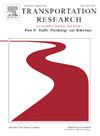“That’s a bit of a tight squeeze!”: A thematic analysis of narrow passage driving interactions using the Perceptual Cycle model
IF 3.5
2区 工程技术
Q1 PSYCHOLOGY, APPLIED
Transportation Research Part F-Traffic Psychology and Behaviour
Pub Date : 2025-02-01
DOI:10.1016/j.trf.2025.01.038
引用次数: 0
Abstract
The ability to accurately represent driver behaviours in microscopic traffic models and for autonomous vehicles to discern human driving behaviours is reliant on having a deep understanding of the behaviour that is being modelled. In spite of this, the decision-making processes undertaken during narrow passage interactions, a high risk and relatively unregulated situation in which a road narrowing means that two opposing vehicles cannot pass through at the same time, remain under investigated. To rectify this limitation, an on-road “think aloud” study was conducted with participants in the UK and supplemented by a video-cued retrospective interview using a shortened version of the Schema World Action Research Method. 175 decision points were then analysed using Neisser’s Perceptual Cycle Model, which highlights the relationships between the information perceived from the narrow passage environment, a driver’s schema, and the actions taken. It was found that drivers conduct four key assessments, including evaluating their interaction partner’s intention and the suitability of give way gaps on both sides of the road, when deciding what actions to take during a narrow passage interaction. These results provide a clearer understanding of how driver behaviour is influenced by different contextual/situational factors in a safety critical driving situation and helps ensure that future mathematical models better reflect driver decision-making during narrow passage interactions. This, in turn, can be used to ensure that autonomous vehicles are able to safely interact with human drivers at narrow passages and that microscopic traffic models are able to produce more accurate outputs.
求助全文
约1分钟内获得全文
求助全文
来源期刊
CiteScore
7.60
自引率
14.60%
发文量
239
审稿时长
71 days
期刊介绍:
Transportation Research Part F: Traffic Psychology and Behaviour focuses on the behavioural and psychological aspects of traffic and transport. The aim of the journal is to enhance theory development, improve the quality of empirical studies and to stimulate the application of research findings in practice. TRF provides a focus and a means of communication for the considerable amount of research activities that are now being carried out in this field. The journal provides a forum for transportation researchers, psychologists, ergonomists, engineers and policy-makers with an interest in traffic and transport psychology.

 求助内容:
求助内容: 应助结果提醒方式:
应助结果提醒方式:


